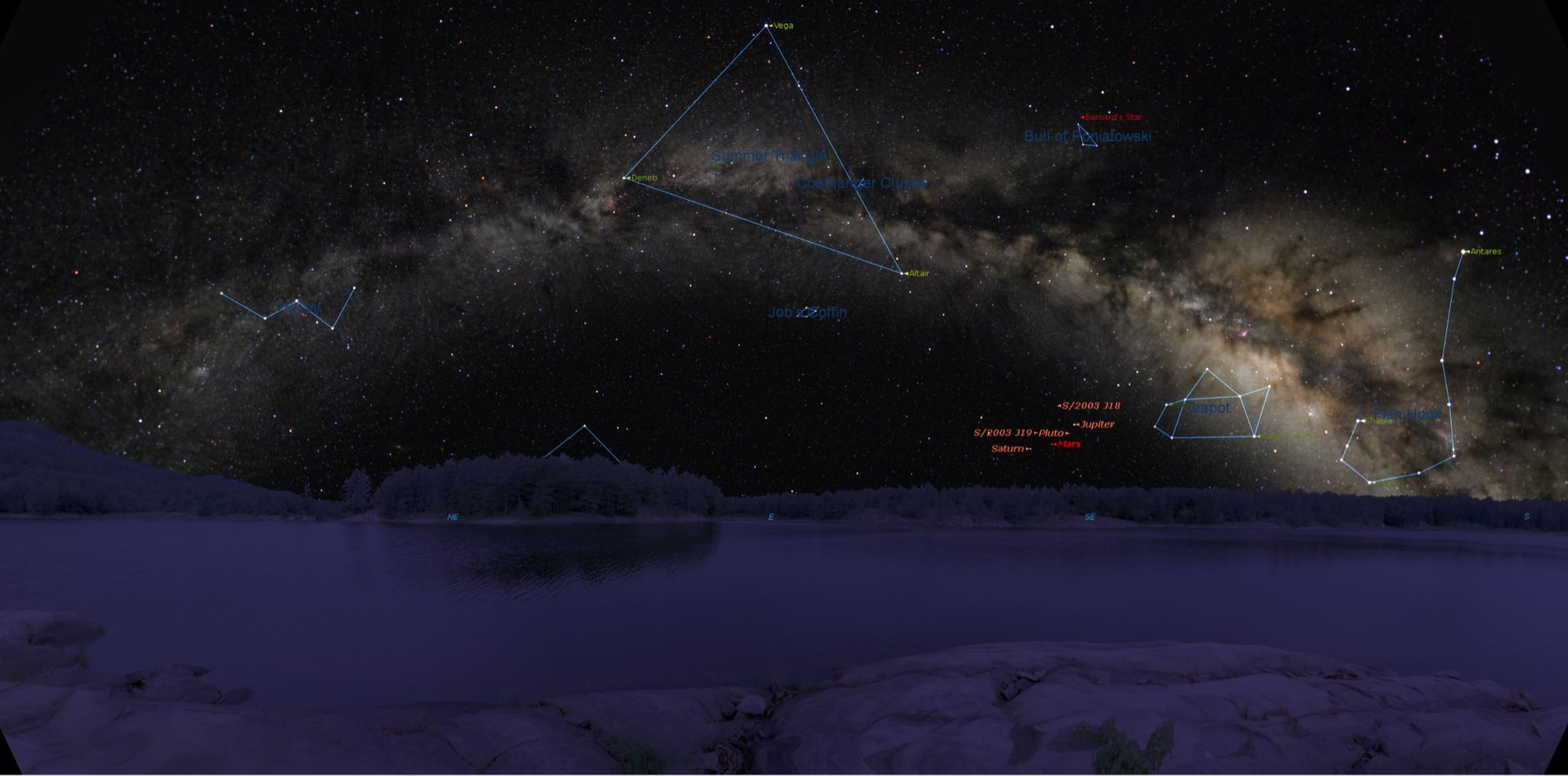EarthSky Community Photos
Submit your photo here. Comment or upvote on photo pages. Search via photographers' names. More improvements coming! To help, please donate.

Generated with "Starry Night" for northern hemisphere viewers.
05:00 am
Not applicable
Not applicable
Let the Show go on!
Its been cloudy here in Upstate NY, but occasionally it has cleared just before Astronomical Dawn (Just a bit after 5am for the next few days). a number of planets have been congregating in a tight cluster on the fringes of Sagittarius just to the left of the "handle" of "The Teapot" and are only now slowly moving away from each other.
So, lets break some of this down for a second. What are we talking about here?
First, Astronomical Dawn is when the first rays of the sun reach out and lighten the sky while it is still well below the horizon, creeping ever so slowly into the darkness and causing it to fade gradually until at first, you hardly notice the stars are becoming less bright unless you are focusing on the dimmer stars when it was fully dark. It doesn't take long, however, before it becomes more obvious and then more pronounced.
For Astrophotographers and astronomers with their sensitive gear and instruments, details begin to vanish and in what seems like no time at all, disappear altogether unless one is viewing the moon, the brighter stars or our planetary neighbors.
This period can actually be useful especially for novice viewers. It removes the distractions of all those less bright background stars and allows the moon, planets, brighter stars and to some extent, what are called asterisms to remain and be readily identified with the naked eye or a small pair of binoculars.
So, what is an asterism? I can name two that most of you in the northern hemisphere will know. The Big Dipper in Ursa Major, and The Little Dipper in Ursa Minor. Orion's belt is another and can be viewed from both hemispheres. They are called asterisms because they resemble familiar objects that can be easily identified. The name of the asterism is not the name of the constellation it resides in.
So this image shows you a few asterisms you may not be familiar with. From left to right, "The W" is in Casseiopia and straddles the northern section of the Milky Way. Next is the "Summer Triangle" comprised of the third brightest star, Vega (top center), Deneb down and to the left touching the topmost fringe of the "Dark Rift" (a dark region of stardust that trails all along the central portion of the Milky Way) and Altair to its right which helps to bracket the middle portion of the rift. This Triangle dominates the night sky during the Milky Way season from early spring until late autumn and between "The W", "The summer triangle", and "The Teapot" in Sagittarius is a sure fire method of determining where the span of the Milky Way resides. Finally, The "Fish Hook" spans the embodiment of the lower segments of Scorpius from his beating heart, Antares (often mistaken for Mars because of its brightness and pinkish red color), along his back all the way up and around to his barbed stinger (Shaula). One of the great prizes for astrophotographers is thus found above and between "The Teapot, and "The Fish Hook". The core of our home galaxy where a recently discovered "SUPER massive black hole" resides with a mass millions of times greater than our sun. Mathematicians are still trying to work out the math, but it is theorized that this object, hidden from our view by the vast dust clouds of the dark rift is very much involved in the formation of our spiral galaxy.
I find "the Teapot" particularly interesting. This time of year from the vantage point of the northern hemisphere, it appears to sit level in the sky and one can picture it boiling away furiously and creating the milky white wisps trailing across the sky all the way from the south to the north. Its spout points right at the core and the dark horse nebula sits in the bubble of that core presenting us with the highest concentration of stars numbering in the billions in that one lone place. Each time I capture a decent image of it, I always get a thrill. I have never tired of it.
As to the image below, this is not a photograph. It is a computer generated and very precise representation of what the night sky will look like at 5am this morning, March 27th, 2020 in less than an hour. NOte the positioning of the planets. If the clouds give us a break, you should be able to plainly see Jupiter, Mars and Saturn all lined up and in proximity of each other. The darker the skies you have, the better it will be. If you are in truly dark skies, you will even be able to see the bands of the Milky Way itself. If the clouds are not your friend this morning, not to worry. It will be the same tomorrow and for a week or so as the only the planets will move with Mars moving off more quickly than Jupiter or Saturn.
I hope some of you enjoy these occasional posts I make. Its a labor of love. I find myself wanting to share these delights and for the next week or so you will see these planets ignoring our pleas for social distancing. Its a party up there. Enjoy!








